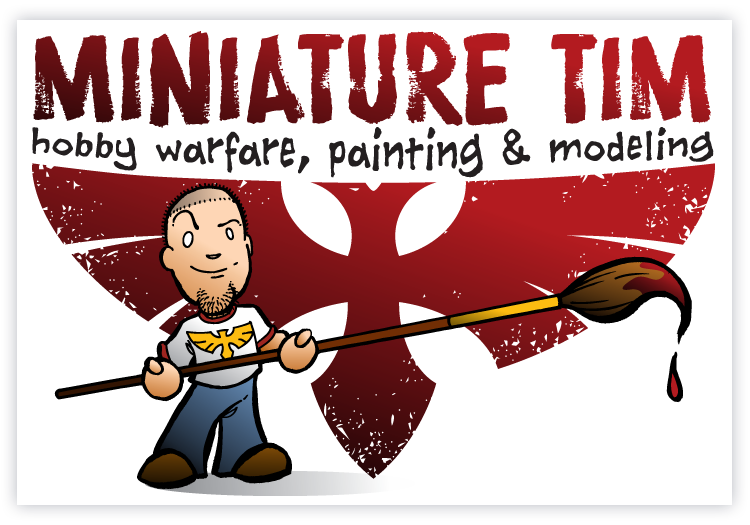After some emails I've received, it appears that the following statement from my last article wasn't exactly agreed on...even if all the comments say otherwise.
"What I won't be debating is whether or not we should be thinning our paints. This is already widely accepted as a need."
Seems some folks really did want me to debate the virtues of thinning your paints, versus painting straight from the pot. Oookay, let's debate it!
I'll be honest here…I try and make my "A Matter of Opinion" articles as unbiased as possible, providing options and pros and cons of each. At the end, I'll typically give you my opinion, but that's all it is, my opinion. If I wanted to set something in stone for myself, and present it as something I think you should as well, I run that in my "Tools of the Trade" series of articles. Unfortunately, my very clear statement of not debating whether we should or shouldn't be thinning our paints was a touch strong for an article based on opinions. That's fine. Let's see some thoughts from both sides.
Not To Thin Your Paints
Why not focus on the reason for this article in the first place, eh? There are actually some very good reasons to not thin your paints. Thinning your paints reduces the intensity of the pigment by reducing the ratio of pigment to liquid. It reduces the thickness of your paint, which can be an issue for coverage, and renders the paint more transparent than originally formulated for. This in turn requires more layers of paint to achieve the same opacity you would have gotten if you hadn't thinned your paint. If you use water to thin your paints and add too much of it, you will break the molecules of the binder within the paint, and the paint will behave oddly with pigment separating and pooling in random spots.
By not thinning your paints, you keep the original color, intensity and viscosity true to how the manufacturer formulated it. You also eliminate the chance of over-thinning your paint and getting inconsistent results across a figure or series of figures.
To Thin Your Paints
Thinning your paints before using them is a wonderful technique to garner you more control while painting. A properly thinned paint allows you to lay down smoother coats to avoid brush strokes in the paint. While a thinned paint will indeed take more layers for an opaque finish, and hence take more time, these coats will have that smooth finish we all want, helping us to avoid that thick-paint look we all hate, especially in the lighter color range like yellows and whites. Whether blending from a mid tone to a shadow, or a mid tone to a highlight, thinned paints will enable smoother transitions because you are laying down less paint.
If you enjoy using an airbrush, an acrylic thinner will enable you to use your favorite P3 and GW paints, or any other brand, right in your airbrush as well! I realize that we aren't specifically talking about airbrushing here, but it is a benefit nonetheless.
I've tried to present both options here equally, and let you choose the road you're most comfortable with. However, if you've never done it, I would encourage you to try it. If you have questions on how, ask me! I'm happy to answer them, and so will the readers who know the answers too, I'm sure.
Ultimately whether or not you thin your paint is up to you. Though I do feel very strongly about this subject, even I have to admit that it's all A Matter of Opinion.
- Tim


I acknowledge that thinning paints gives you more control, however for me it's all a question of time. I have far too much to paint and too great a desire for fast results to spend time painting multiple coats of each colour.
ReplyDeleteIf I was painting to enter contests or simply to admire things on a shelf, I would probably thin paints. However, as a player wanting tabletop quality with a backlog of thousands of models, painting straight from the pot feels the best approach for me.
I completely understand and acknowledge the validity of your situation :) I would, however, also encourage and suggest that the thinning of your paints for very specific purposes, like some of the detail work on the models, may still actually help you save time as the paint is indeed easier to control.
DeleteHooding is right. I usually worked from the pot when I was painting my armies and just to table top standard. After leaving the gaming side and focusing on becoming a cabinet/display painter I will tell you there is no argument. If you want a very high quality paint job with seamless blending and a professional look you will have to thin your paints and take your time. I would venture to say it's less a matter of opinion so much as a matter of application ;)
ReplyDeleteYES! :) Exactly as I suggested above, just put into another situation. no matter what it's a matter of application and what works best for you, at any specific time.
DeleteA difficult argument to weigh up.
ReplyDeleteI do tin my paints, but not always!
I find that Whites, Yellows and Oranges need to be used straight from the pot.
Therefore which argument is right?
Neither it is (like most things) a matter of choice - as my olde science teacher used to say, all things in moderation.
Tony
Ahh, but whites, yellows and oranges, of what paint line? Even the specific paint lines may or may not need thinning depending on color.
DeleteI'd say your old science teacher has the right of it as well. too much of anything isn't going to do anyone any good.
Thinning paint is safer, since you could always apply another layer.
ReplyDeleteStill, if you're unsure, you could use Elcometer 500 to measure paint thickness